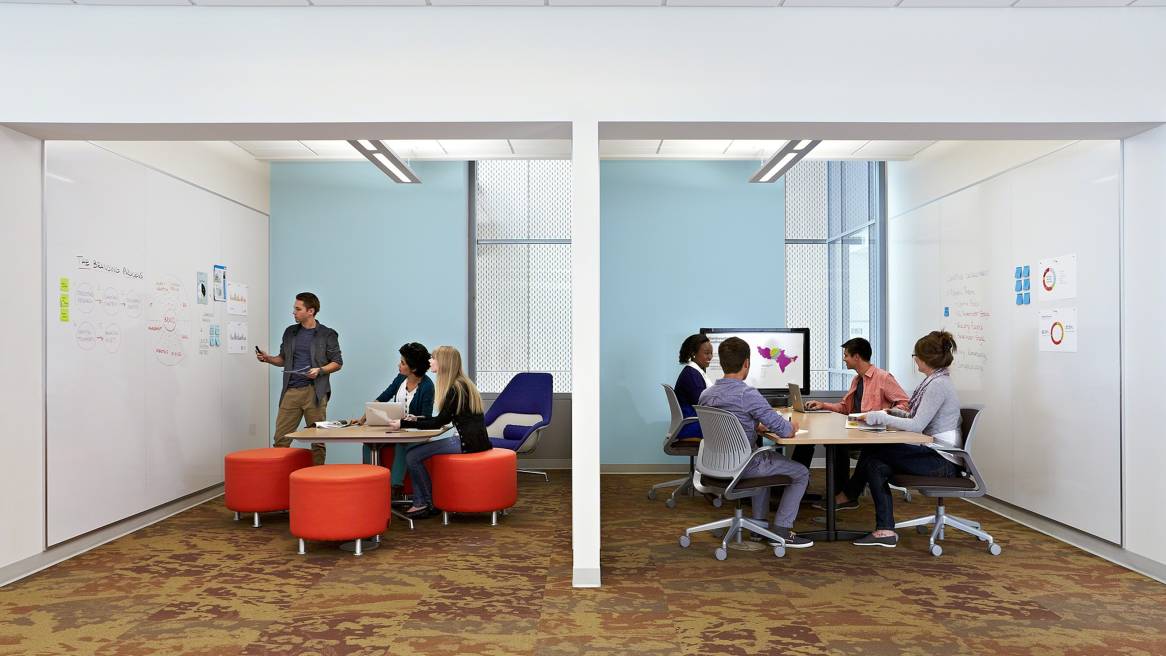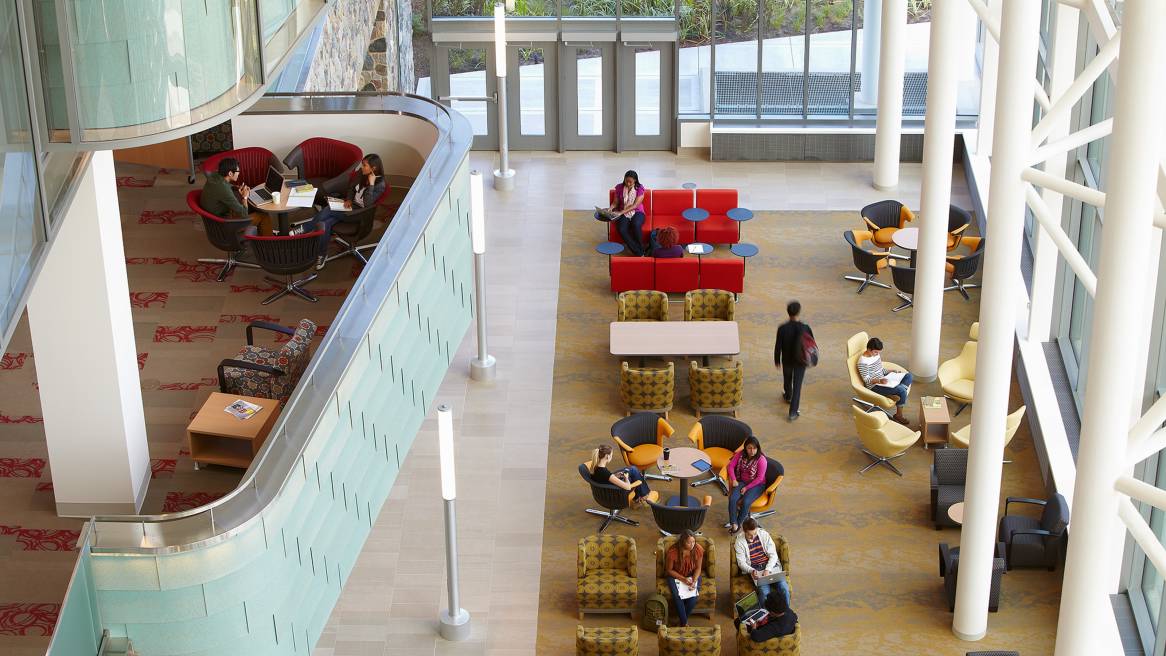Future-Ready Libraries
How libraries can be a campus catalyst to prepare students for what's next.
Do e-books, digital information and active learning mean that campus libraries will inevitably become a thing of the past? Absolutely not. Books on shelves may be becoming more dormant, but progressive schools everywhere are discovering ways to transform their libraries into dynamic flexible learning spaces for diverse ways of learning and knowledge creation.
Traditionally, libraries were very rigid places where people could go to look up information that they didn’t have access to elsewhere. “There were lots of rules. Don’t talk. Move that book to that table only. Definitely don’t have any food in here. Don’t move the furniture,” recalls Jim Brockman, a high school assistant principal in St. Louis, Mo. But now, he says, “It’s tools. It’s opportunities. It’s collaboration spaces. It’s meeting experts in fields and being able to pick the brain of those people and to pursue their passions. That’s the library of today.”
In fact, on some campuses, the role of the library has changed so dramatically that the building now bears a new name: the learning commons.
Steelcase Education has closely studied this rapid evolution of libraries: visiting campuses, interviewing, observing and listening. Learnings from educators, librarians and administrators, uncovered new insights into ways the library can be reinvented for what’s now, and what’s next.
Libraries are a catalyst for evolution on campus.
Often the largest learning environment on campus, the library is a place where students can feel inspired and supported. It’s also a place to build skills that may not be taught in classrooms – across-the-disciplines investigations, hands-on creative explorations of ideas or gaining new technology skills, for example. In fact, today’s libraries are as likely to have a café, a maker space and a digital scholarship center as they are to contain reading rooms, study carrels and seemingly endless stacks of books.
Expanding on their legacy role as an academic hub that’s the heart of the campus, today’s libraries are rapidly morphing into multipurpose places of connection where students, faculty, library staff and even members of the community can work and interact freely, developing the cognitive, social and emotional competencies that are essential for meaningful impact in today’s world.
“Libraries of the future are innovative and collaborative and inspirational….They’re places for community and academic support as well as social spaces.”
Ann Roll I Associate Dean of collections and Scholarly CommunicationsCalifornia State University, Fullerton
Libraries are interdisciplinary, inclusive and inspiring.
Most people go to the library for the same reason: to learn something they don’t already know. As several librarians described to us, libraries are places where journeys of discovery begin. For that reason, a library should be a nonthreatening place that feels like it belongs to each person who uses it, whether you’re a tenured Ph.D. faculty member or a first-generation college student — a place where everyone is a learner and even students can be teachers.
“We really transformed our service model to encourage student experts to train their peers and I’ve seen that succeed in a variety of ways,” says Alison Benadetti, a library director at UCLA. Student-to-student writing consultation services, student library assistants and student aides for freshmen in a special program are all available here.
Libraries are at the intersection of scholarly, social and emotional needs.
Today’s libraries are increasingly a gathering spot where students can develop across multiple dimensions, not just gain what can be learned from books.
“We need to think about the library as not just a place to provide help and support, but also as a second home, a space that feels welcoming and not intimidating,” says Carlos Rodriguez, dean of the university library at Cal-State in Los Angeles. “Ideally, the space can adapt and be the container for the expertise, the interactions and the services – a place where students can discover not just new information and new knowledge, but also really discover themselves and how they can contribute to society.”
Libraries are adaptable, scholarly spaces that support the rhythm and range of learning.
Learning isn’t just a single mode. It’s a changing rhythm of focus and interaction, collaborating and socializing, rest and rejuvenation. It’s working with technologies as well as books, whiteboards and sticky notes. It’s people finding out how and where they work best, depending on their task and mood. The library plays a huge role in making all that happen when it offers choices that support the different rhythms of scholarship and the differing needs of people.
“We need to have the space, the seating, the tools, the technology, and we need the ability to use it all in a coordinated way,” says Chris Carter, director of organizational effectiveness for the libraries at the University of Texas at Austin. “Throughout the day, the space will change from one use to another. We need it to be seamless. We need it to be self-service. And we need the space itself to support all the different types of functions.”

A New Spatial Paradigm
Libraries used to be defined by what was in them – i.e., the books on the shelves. More and more, they’re being defined by what happens in them. Rather than a singular focus of, “I go, I read, I leave,” educators are looking for ways to create libraries that have a more dynamic purpose.
Accomplishing all that requires more than a mindset shift; it also requires embracing a shift in design principles in order to create formal, informal and social learning spaces that support expanded services and technologies plus a wide range of user behaviors, preferences and activities. For most libraries, the biggest challenge involves designing for connection and collaboration, while still fully supporting individual discovery. This requires very carefully planning adjacencies and the relationships between people, tools, furniture and the overall space. Access to power and necessary technologies everywhere has become essential, as well as easy-to-spot areas where help is available, whether from peers, faculty or library staff.
Different types of seating and tables should comfortably support postures appropriate to the task – whether that’s sitting up straight, perching, lounging or standing. Additionally, providing different levels and types of privacy – visual, acoustical and territorial — helps people be more productive and feel at ease. And easy-to-move furniture, whiteboards, privacy screens and dividers encourage adapting spaces to fit the needs of the moment, while also ensuring future flexibility for the library as a whole.
No question, libraries are changing. Rather than staying stuck in the past, leading educators are stepping up to the challenge: thinking through opportunities, changing course and leveraging the power of space to support new ways of discovery and learning.
Interested in learning more?
Check out our podcast “Rethinking the Heart of Campus.”


